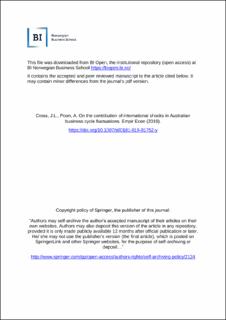On the Contribution of International Shocks in Australian Business Cycle Fluctuations
Journal article, Peer reviewed
Accepted version
Permanent lenke
https://hdl.handle.net/11250/2650894Utgivelsesdato
2019Metadata
Vis full innførselSamlinger
- Publikasjoner fra CRIStin - BI [1015]
- Scientific articles [2181]
Sammendrag
What proportion of Australian business cycle fluctuations are caused by international shocks? We address this question by estimating a panel VAR model that has time-varying parameters and a common stochastic volatility factor. The time-varying parameters capture the inter-temporal nature of Australia’s various bilateral trade relationships, while the common stochastic volatility factor captures various episodes of volatility clustering among macroeconomic shocks, e.g., the 1997/98 Asian Financial Crisis and the 2007/08 Global Financial Crisis. Our main result is that international shocks from Australia’s five largest trading partners: China, Japan, the EU, the USA and the Republic of Korea, have caused around half of all Australian business cycle fluctuations over the past two decades. We also find important changes in the relative importance of each country’s economic impact. For instance, China’s positive contribution increased throughout the mining boom of the 2000s, while the overall US influence has almost halved since the 1990s
